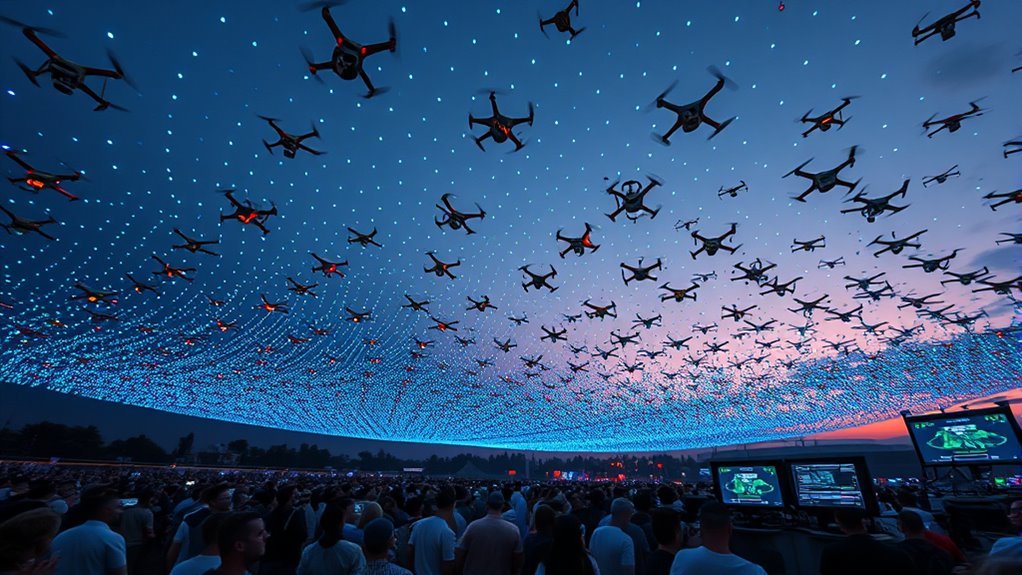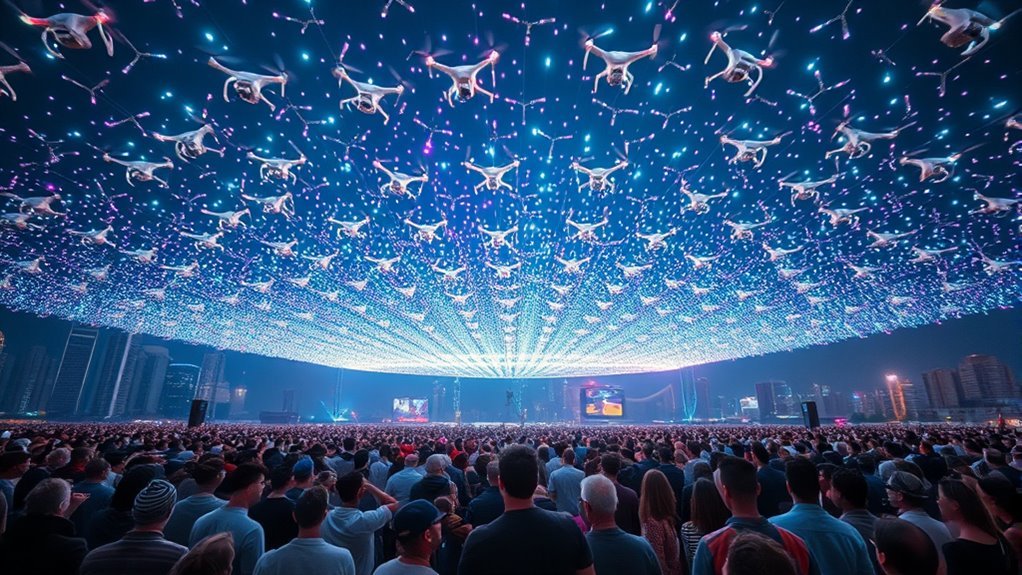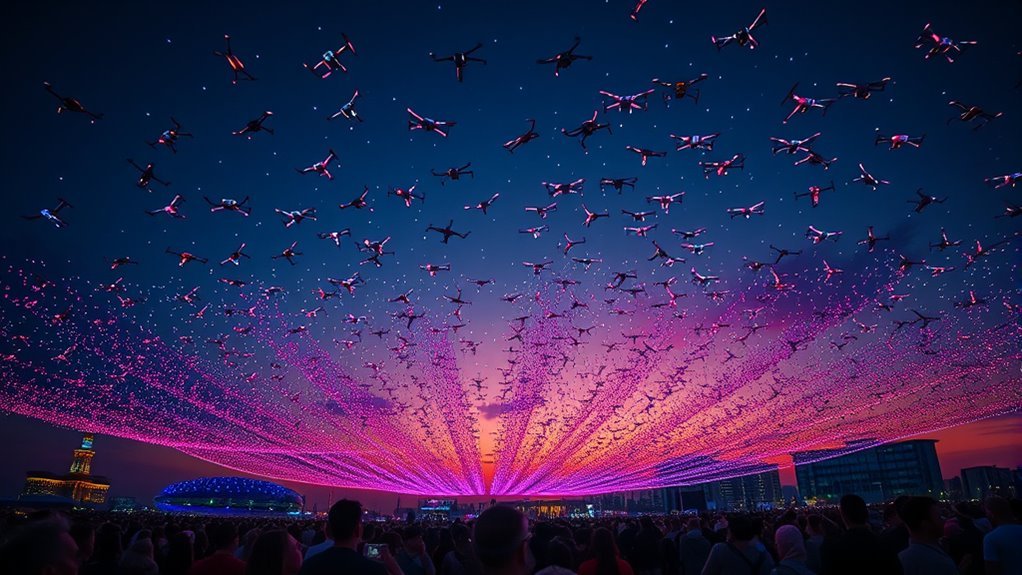Several factors influence how many drones are in a drone show. Your budget, venue size, and technological capabilities play critical roles. Larger budgets allow for more drones and advanced choreography. Venue dimensions dictate how many drones can be accommodated safely. Additionally, synchronization requirements and regulatory restrictions limit drone numbers. You also need to evaluate environmental factors and performance duration. Understanding these elements helps optimize your show, and insights into each factor can enhance your planning process.
Budget Considerations

When planning a drone show, budget considerations play a pivotal role in determining the overall feasibility and scope of the event. You need to conduct a thorough cost analysis to understand how much you can allocate for various components, such as drone technology, software, and operator expertise. Budget allocation should prioritize essential elements to guarantee safety and performance while allowing for creative freedom.
Consider hidden costs, like permits or liability insurance, which can greatly impact your total expenditure. By meticulously evaluating each aspect, you can identify opportunities for cost-saving without compromising quality. Ultimately, a well-structured budget fosters innovation and enhances the potential for an unforgettable drone display that resonates with your audience’s desire for freedom and creativity. Additionally, understanding the payload capacities needed for your show can significantly influence overall cost and logistics.
Venue Size and Layout

The venue’s size and layout are crucial factors that can greatly influence the success of a drone show. When considering venue dimensions, you need to evaluate how they align with your show’s requirements. A larger venue allows for a greater number of drones and more complex formations, while a smaller space might limit these possibilities. Additionally, audience capacity directly affects the visibility and overall experience of the show.
- Height restrictions: Consider any overhead limitations that might impact drone performance.
- Audience arrangement: Verify clear sightlines for all attendees to enhance engagement.
- Safety zones: Establish designated areas to protect both the audience and drones.
Furthermore, flight performance comparison is essential to determine how many drones can be effectively utilized in the available space and conditions. The synchronization with music is also vital, as it can dictate the number of drones that can perform intricate maneuvers without compromising the overall show quality.
Understanding these elements is fundamental for orchestrating an impressive and safe drone show experience.
Technological Capabilities

When planning a drone show, you need to take into account the technological capabilities that directly impact performance. Flight control systems play an essential role in coordinating movements, while battery life limitations can restrict show duration. Additionally, the efficiency of communication technology influences how effectively drones operate in unison, affecting the overall quality of the display. Moreover, companies like SkyMagic Drone Light Shows are known for their innovative technology, enhancing the precision and synchronization of drone performances. Advanced algorithms enable real-time adjustments that further optimize the choreography of the show, ensuring a captivating experience for the audience.
Flight Control Systems
Although various factors contribute to the success of drone shows, flight control systems play a pivotal role in ensuring precise maneuverability and synchronization. These systems are essential for achieving complex aerial displays, allowing you to experience a seamless blend of artistry and technology.
Key elements include:
- Autonomous navigation: Enables drones to fly predetermined paths without manual intervention.
- Real-time adjustments: Allows for immediate corrections in flight paths to maintain formation integrity.
- Dynamic communication: Facilitates coordination between multiple drones to execute synchronized movements.
Battery Life Limitations
Flight control systems enable intricate maneuvers, but these capabilities are inherently limited by battery life. You’ll find that battery performance directly impacts how many drones can be deployed in a show. Shorter flight times constrain the number of drones, as each unit requires sufficient energy to complete its tasks. Energy efficiency becomes essential; optimizing power consumption allows drones to operate longer and perform more complex sequences. You should consider the trade-offs between performance and battery life when planning a show. Advanced battery technologies can enhance performance, but they often come with weight penalties that affect maneuverability. Ultimately, the balance between battery capacity and energy demands shapes the scale and intricacy of your drone display, dictating the overall visual impact.
Communication Technology Efficiency
As drone shows grow in complexity, the efficiency of communication technology becomes essential for coordinating multiple units in real time. Effective communication protocols minimize signal interference, ensuring seamless operation among drones. When you consider the scale of these shows, the following factors are vital:
- Latency: Low-latency communication enables drones to respond instantly to commands, vital for synchronized movements.
- Redundancy: Robust systems with backup protocols help maintain control even in the presence of interference.
- Encryption: Securing communication channels prevents unauthorized access, safeguarding the show’s integrity.
Choreography Complexity
When evaluating choreography complexity in drone shows, you’ll want to contemplate dance patterns and movements that contribute to the overall performance. Synchronization requirements play a crucial role in ensuring that each drone operates in harmony with others, enhancing the visual impact. Additionally, effective visual impact design can greatly elevate the audience’s experience, making choreography an essential element of drone show production. The use of advanced flight path algorithms allows for precise coordination and fluidity in the drones’ movements, further enriching the performance. Furthermore, the safety protocols implemented, such as real-time collision avoidance, ensure that the choreography can be executed without compromising safety during the show.
Dance Patterns and Movements
While the visual appeal of drone shows often hinges on their choreography complexity, the intricacies of dance patterns and movements play an essential role in delivering an enchanting experience. Effective drone choreography relies on precise movement coordination and the ability to execute complex formations. The beauty lies in how drones interact, forming shapes that captivate the audience.
- Dynamic formations: The change between different shapes adds depth to the performance.
- Fluid shifts: Smooth movements create a seamless flow, enhancing visual storytelling.
- Layered patterns: Overlapping drones achieve a three-dimensional effect, enriching the spectacle.
Synchronization Requirements
Effective synchronization is essential for achieving choreography complexity in drone shows, since even the slightest deviation can disrupt the visual harmony. Synchronization challenges arise from the need for precise timing accuracy among multiple drones, which must operate in unison to create a cohesive performance.
Here’s a simple overview of synchronization factors:
| Factor | Description | Impact on Show |
|---|---|---|
| Timing Accuracy | Precision in drone movements | Guarantees visual alignment |
| Number of Drones | More drones increase complexity | Higher synchronization demands |
| Environmental Factors | Wind, obstacles, and tech | Can cause deviations |
When you grasp these elements, you can appreciate the intricacies involved in creating a stunning drone show that captivates audiences while adhering to technical requirements.
Visual Impact Design
As the intricacies of choreography complexity unfold, the visual impact of a drone show becomes increasingly reliant on meticulous design elements. You’ll find that the interplay between visual aesthetics and thematic elements creates a fascinating experience. The complexity of choreography greatly influences how drones move, forming patterns that resonate with audiences.
- Thematic coherence enhances audience engagement, guaranteeing that every movement aligns with the overall narrative.
- Precision in timing and formation shifts fosters a seamless visual experience, elevating the show’s impact.
- Variability in drone formations allows for dynamic visuals, keeping the audience’s attention throughout the performance.
Incorporating these factors guarantees that your drone show not only dazzles but also resonates on a deeper level with viewers, granting them a sense of freedom in their interpretation.
Audience Engagement
How do drone shows captivate their audiences? The key lies in effective engagement techniques tailored to audience size. Larger crowds often require dynamic displays that encourage collective participation, while smaller groups might benefit from more intimate interactions. Techniques like synchronized music, interactive light patterns, and real-time audience feedback can elevate the experience, fostering a sense of connection. By manipulating drone formations and incorporating audience input, shows can create a narrative that resonates deeply. Additionally, leveraging technology such as mobile apps to enhance viewer involvement guarantees audiences feel a part of the spectacle. Ultimately, the success of a drone show hinges on its ability to transform passive viewers into active participants, enriching their experience and reinforcing the freedom of expression inherent in art. Furthermore, the choice of drone technology, such as synchronized music and advanced features in systems like DJI, can significantly enhance the overall impact of the performance. Asylon’s automated systems can also boost operational efficiency, ensuring optimal execution of aerial displays.
Regulatory Restrictions
While the allure of drone shows captivates audiences, regulatory restrictions greatly shape their execution and planning. Maneuvering the landscape of regulatory compliance is essential for any organizer. These restrictions can limit the number of drones you can deploy, particularly in densely populated areas or near airports. Effective airspace management guarantees safety, but it also constrains creative possibilities.
Regulatory compliance is crucial for drone shows, balancing safety with the potential for creativity.
Consider these factors:
- Local laws: Different regions have varied regulations affecting drone usage.
- Safety protocols: Compliance with safety measures protects both spectators and participants. Additionally, maintaining a minimum horizontal distance from people and buildings is crucial for ensuring safety during drone shows.
- Permitting processes: Obtaining necessary permits can delay or limit show planning. Additionally, registration requirements for certain drone types must be considered to ensure adherence to local regulations.
Understanding and adhering to these regulations is key to successfully orchestrating a drone show that respects both creativity and compliance.
Weather Conditions
Although drone shows can create mesmerizing displays, weather conditions play a critical role in determining their feasibility and success. When considering the number of drones you can deploy, rain impact is a significant factor; moisture can interfere with electronics and lead to malfunctions. Furthermore, high wind speeds can jeopardize the stability and precision of drone formations. Each drone has a specified wind resistance threshold, and exceeding this can result in erratic movements or crashes. Therefore, evaluating the forecast is essential before planning your show. Ideally, you want calm, dry conditions to guarantee safety and peak performance. Additionally, snowy conditions can significantly impact visibility and navigation, which are crucial for maintaining drone formation. Balancing these elements allows for a more dynamic and enchanting experience, ultimately enhancing the freedom of expression through technology. Additionally, the flight duration and battery performance of the drones can also affect their ability to operate effectively in varying weather conditions.
Performance Duration
When planning a drone show, the performance duration is a vital consideration that directly influences audience engagement and overall impact. Optimizing this duration can greatly enhance the performance impact, ensuring your audience remains captivated throughout.
- Shorter durations often create a sense of urgency and excitement.
- Longer performances allow for more intricate displays and storytelling.
- Finding the right balance is essential for maximizing viewer satisfaction. Additionally, the number of drones used in the show can affect the performance duration, as approximately 50 drones are often deployed for coordinated flight patterns and light displays, balancing operational complexity with visual impact. As performances evolve, they can now feature over a thousand drones, showcasing increased complexity in their displays.
Frequently Asked Questions
How Do Drones Communicate During a Show?
Ever wondered how drones move in perfect harmony? They use advanced drone technology and signal synchronization to communicate, ensuring each drone follows precise commands, creating stunning visual displays while maintaining safety and efficiency throughout the show.
Can Drones Perform in Indoor Spaces?
Yes, drones can perform indoors, but you’ll face challenges like indoor logistics and spatial limitations. Careful planning guarantees they navigate effectively, maintaining safety while delivering impressive performances in constrained environments.
What Safety Measures Are in Place for Drone Shows?
As you watch the mesmerizing drones dance, safety regulations guarantee your peace of mind. Emergency protocols are in place, ready to activate, should anything go awry, allowing you to enjoy the spectacle without worry.
How Is the Battery Life Managed During Performances?
During performances, you’ll find battery management essential for performance optimization. Operators monitor battery levels continuously, ensuring drones have adequate power, while employing strategies like staggered flights to maximize show duration without compromising safety or visual impact.
What Types of Drones Are Typically Used in Shows?
Imagine a symphony of lights; typically, high-performance drones with advanced specifications are used, ensuring precise show choreography. Their agility and responsiveness create mesmerizing displays, enchanting audiences while allowing creators to express their artistic freedom.

